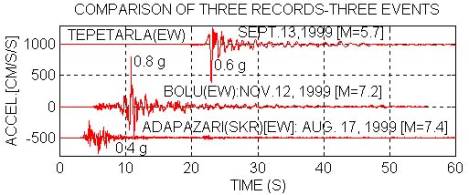 |
|
|
Introduction
|
INTRODUCTION The August 17, 1999 Izmit (Turkey) earthquake (Mw=7.4) will be remembered as one of the largest earthquakes of recent times that affected a large urban environment (U.S. Geological Survey, 1999). This significant event was followed by many significant aftershocks and another main event (Mw=7.2) that occurred on November 12, 1999 near Duzce (Turkey). The shaking that caused the widespread damage and destruction was recorded by a handful of accelerographs (~30) in the earthquake area operated by different networks. The characteristics of these records show that the recorded peak accelerations, shown in Figure 1, even those from near field stations, are smaller than expected (Çelebi, 1999, 2000)*. Following this main event, several organizations from Turkey, Japan, France and the USA deployed temporary accelerographs and other aftershock recording hardware. Thus, the number of recording stations in the earthquake affected area was quadrupled (~130). As a result, as seen in Figure 2, smaller magnitude aftershocks yielded larger peak accelerations, indicating that because of the sparse networks, recording of larger motions during the main shock of August 17, 1999 were possibly missed.
Figure 1. Map showing some of the peak accelerations recorded and plotted at relative locations of significant strong-motion stations within and in close proximity to the epicentral area (Base map courtesy of BKS Surveys Ltd., N. Ireland).
Figure 2. Comparison of peak accelerations for the August 17, 1999 main shock (station SKR) and two aftershocks, each recorded at a different location (Çelebi, 2000). It is accepted a priori that each organization had a different objective in deploying temporary stations. Regardless of the varying objectives, the recorded main shock and aftershock motions exhibit specific characteristics of engineering importance and provide opportunities to further research many aspects of the earthquakes of 1999 for applications in Turkey and other similar seismic regions of the world. Several research results have either been published or will be published in the near future. To help the user of this CD-ROM, we organized a PUBLICATIONS Directory which includes some of the publications relevant to the 1999 Turkey earthquakes.
* Çelebi, M. , Toprak, S., and Holzer, T., 1999 and 2000, Strong-Motion, site-Effects and Hazard Issues in Rebuilding Turkey: in Light of the 17 august 1999 earthquake and its aftershocks , invited paper, PROC. ITU Conference on Marmara Earthquake of August 17, 1999: Scientific Assessments and Recommendations for Rebuilding, Istanbul Technical University, Istanbul, Turkey, 2-5 December 1999. [also selected and published in International Journal for Housing Science and its Applications (IAHS), v. 24, n. 1, pp.21- 38 and in Special Volume titled �The 1999 Izmit and Duzce Earthquakes: Preliminary results (eds. A. Barka, O. Kozaci, S. Akyuz and E. Altunel), pp. 247-263, 2000].
|

